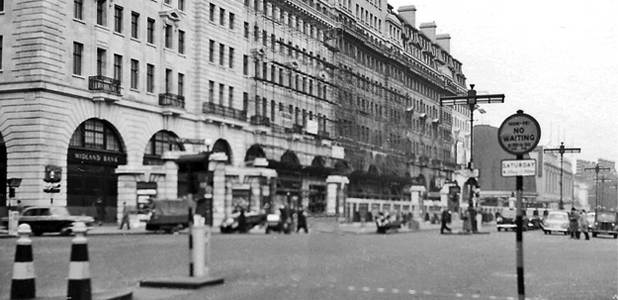 London. September, 1971. Sherlock Holmes’s own street becomes witness to one of the largest bank robberies in UK history, when thieves tunnel into the vault of Lloyds Bank and make off with over £3 million.
London. September, 1971. Sherlock Holmes’s own street becomes witness to one of the largest bank robberies in UK history, when thieves tunnel into the vault of Lloyds Bank and make off with over £3 million.
-
And here’s the rub: when an amateur radio enthusiast, Robert Rowlands, picks up the thieves’ walkie-talkie communications and tips off the police prior to the robbery, the reaction is lackadaisical.
-
And the other rub: three days after the heist, the media goes silent. The government issues a D notice—an order that prevents the press from reporting further—and the rest, as they say, is silence.
-
Except for one more element in the case. Inside the vault, a message is found: “Let Sherlock Holmes try to solve this.” Does the great Moriarty remain at large?
The Baker Street robbery was a robbery of the safe deposit boxes at a branch of Lloyds Bank on the corner of Baker Street and Marylebone Road, London, on the night of 11 September 1971. The robbers had rented a leather goods shop named Le Sac, two doors down from the bank, and tunnelled a distance of approximately 50 feet (15 m) passing under the intervening Chicken Inn restaurant. To avoid being overheard they only dug during weekends. They used a thermal lance to try to break into the vault but ultimately had to use explosives.
Robert Rowlands, a radio ham operator, overheard conversations between the robbers and their rooftop lookout at about 11 pm. He contacted police and tape recorded the conversations while the robbery was in progress, but there was insufficient information to identify which bank was being robbed. At 2 am a senior police officer alerted radio detector vans to track down the gang. Police checked the 750 banks within 10 miles of Mr Rowlands’ receiver, including the Baker Street bank. At the time, the thieves were still in the bank, but the police failed to realise the fact because the security door was still locked. The thieves got away with £1.5m cash (2010: £16.5m) and valuables from safe deposit boxes.
The total haul was believed to be near £3m (2010: £33.1m)
It has often been reported that after four days of news coverage British authorities issued a D-Notice, requesting that such reporting be discontinued for reasons of national security and that the story disappeared from newspapers. It is claimed by national newspapers in recent years, that some of the security boxes contained embarrassing or nationally sensitive material and that the purpose of the request was to protect a prominent member of the British Royal Family. Rowlands, the aforementioned ham radio operator, claims that the police attempted to prevent him from talking to the press by means of the D-Notice, which he felt was an attempt to hide police incompetence. He also claims that police threatened to prosecute him for listening to an unlicensed radio station. An investigation some years later showed that a request had never been made to the D-Notice committee at that time. Furthermore, a D-Notice has no legal status, being a mere request and not a legally enforceable order. The Times newspaper was still reporting about the case over two months later.
Other recent reports suggest that the identity of the criminals and their sentences have never been revealed. However, The Times (amongst other newspapers) reported in January 1973 that four men had been convicted of the robbery at a trial at the Old Bailey. Three of these men were named as: Anthony Gavin, 38, a photographer from Dalston; Thomas Stephens, 35, a car dealer fromIslington; and Reginald Tucker, 37, a company director from Hackney, who all pleaded guilty and who each received twelve years imprisonment. The fourth man, Benjamin Wolfe, 66, a fancy goods dealer from East Dulwich, pleaded not guilty but was subsequently convicted and received eight years. Wolfe had signed the lease on the shop used by the robbers. Two other men accused of handling banknotes from the robbery were acquitted. According to one press report, the police believed that the mastermind of the crime was another London car dealer who was never apprehended
Originally posted 2016-04-20 12:28:06. Republished by Blog Post Promoter













